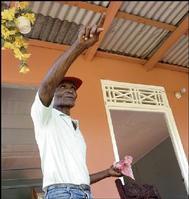Howard Campbell, Gleaner Writer 
Isaac Johnson, owner of the house in Kraal district, Clarendon, where four persons, including two women, were killed in 2003, laments the decision made by the jurors on Tuesday, December 20. - Ricardo Makyn/Staff Photographer
SIX MONTHS ago, closing time at Joseph and Velma Azan's wholesale in May Pen was usually determined when the last customer got served. But after Mr. Azan's older brother, Maurice, was murdered by gunmen in May the husband and wife partners pulled their shutters as soon as the sun set.
Maurice Azan and his stepson Lloyd Phang were killed at Mr. Azan's business place, just a hop and skip away from his brother's store. According to Mrs. Azan, it has become too dangerous to stay open in May Pen and other sections of Clarendon once night falls.
"Nobody antagonise us but we don't know what will happen with people who don't know us so we try to stay out of the way," she told The Sunday Gleaner. "We used to close like 7:00 (p.m.) or 8:00 (p.m.) on weekdays but now it's like 5:30. We try to get out of May Pen as soon as possible," Mrs. Azan added.
May Pen, Clarendon's chief town, has been the parish's business hub for years even in the days when sugar plantations drove its economy.
GHOST TOWN
Residents say the town square, crammed with people in the days, transforms into a ghost town when the sun disappears.
Last week's not-guilty verdict in favour of three policemen in the much-debated Kraal trial once again placed Clarendon in the spotlight.
Senior Superintendent Reneto Adams, Corporal Patrick Coke and Constable Shane Lyons were freed after a 12-member jury cleared them of the May 7 murders of four persons at a house in Kraal, a district in northwest Clarendon.
Crime, especially homicides, in the parish, have not subsided since that bloody incident. Sixty-nine persons were murdered there in 2004, the third highest in the country (behind Kingston and St. Andrew and St. James) and this year has been no different.
While Superintendent Terrence Bent, crime chief for the parish, declined to give homicide figures for 2005, he said it has surpassed last year's.
ISLANDWIDE PROTEST
The Azan/Phang murders sparked a day-long, islandwide protest in June against crime by the Private Sector Organisation of Jamaica.
In September, Paul Howell and his wife Yanique were murdered at their home at a squatter settlement in Sandy Bay. On November 5, Frederick Maragh, a popular businessman, was killed by gunmen at his service station in Hayes.
There was a triple murder on November 12 in Sandy Bay where police found the bodies of Roy Thompson, his son Randy and his nephew shot along Highway 2000.
On December 12, Kent Campbell and Anthony Authurs, both higglers, were shot at Stork Street in May Pen. To round off a bloody year, four persons were murdered last Sunday as they returned from a wake at Juno Crescent.
Otis Smith, one of the men killed in the Juno Crescent incident, was reportedly wanted by the police for the murders of Mr. Azan and Mr. Phang.
He was also being sought for the death of Randolph Turner, another Clarendon entrepreneur.
Superintendent Bent, who has been in charge of policing Clarendon for the past two years, notes that not a lot of the crime there is home-grown. He says many of the persons who occupy the informal settlements in the parish migrate from other areas.
VIOLENCE 'HOT SPOTS'
"On a whole, there are 36 hot spots in Clarendon, which is a lot like Spanish Town," he said. "There are a lot of low-income families and informal settlements which usually influence movement (of people) and that can lead to a lot of crime."
Canaan Heights, Havana Heights, Sevens Heights (also known as Farm), Sandy Bay, Halse Hall and Racetrack are just some of the informal settlements in Clarendon where Superintendent Bent says crime is most rampant.
He says because of the rugged conditions of these areas, it is difficult to track criminals. Policing them, he stated, "is a challenge".
Aldo Brown, president of the Clarendon Chamber of Commerce, believes crime can be significantly reduced if access to land in some of these 'communities' are regulated.
"People in these areas make it easy for others to come in and establish dwelling. Suprisingly, some of the best areas, based on geographic location, are taken by informal settlers," he said.
Mayor of May Pen, Milton Brown, says while the Clarendon Parish Council authorises persons to build houses on these lands, most of the residents do so without permission.
He explained that because most of these lands are owned by government, it is out of the parish council's powers to remove them.
Following the murders of the Howells, Aldo Brown and his committee met to devise a strategy that would help ease fear among May Pen's businesspeople. Setting up surveillance cameras throughout the town was high on their agenda.










